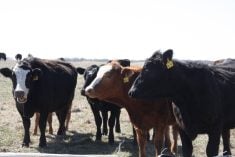Fed market softens
Alberta fed steers and heifers both traded softer compared to the previous week, averaging $263.75 and $262.64 per hundredweight, respectively.
Dressed sales were reported at $433-$440/cwt delivered. Packer competition was moderate with one packer not buying.
Read Also

Why feds imposed EV tariffs
Moe and Kinew have a fight on their hands when it comes to eliminating the EV tariff. Canada has to worry about pissing off the U.S. and Mexico and hundreds of thousands of auto workers.
The Alberta cash-to-futures basis weakened $4.38/cwt at $11.19/cwt. This is the second strongest basis for the same week in the past five years.
Ontario steer carcass weights reached a new record high last week at 1,042 pounds, which is 82 lb. heavier than last year. The Cargill strike showed no signs of resolution last week so carcass weights may remain heavy.
Furthermore, the Canadian steer carcass weight increased 10 lb. from the previous week to 888 lb. Seasonally, steer carcass weights typically bottom in June and gradually increase throughout the second half of the year.
In the U.S., sales were at US$185-$186.50/cwt in the south, with around 5,000 head trading. Northern sales ranged $190-$195/cwt live, and $301-$307/cwt dressed, with almost 7,000 head trading.
Last week’s slaughter estimate is 615,000 head, marginally higher than the previous week. Year to date total slaughter is around 4.5 per cent lower than last year. Steer carcass weights continue to be historically heavy for this time of year.
Year to date U.S. beef production is down 1.6 per cent as the decline in slaughter was partially offset by heavier fed carcass weights.
Feeders steady to higher
In Western Canada, steady to higher prices were noted on most classes of cattle and 700-925 lb. feeders have seen the larger price jump in recent weeks. Heavier feeders over 950 lb. have not quite seen the price jump but demand is picking up.
In Eastern Canada, it is a different story. With fed cattle being shipped at a slower pace than normal, demand for bunk replacements has softened. From their highs a few weeks ago, Ontario steer calf (550 lb.) prices have declined $35/cwt and 850 lb. steer prices are at the lowest point since early March.
Last week in Alberta, some last-minute grass orders were filled. Heifer volumes have been much larger than steers. In some cases heifers make up 75 per cent of the total feeder offerings. Seasonally, it is not uncommon to see larger heifer numbers during May and June.
Last week, Alberta 950 lb.+ heifers for September delivery traded around $320/cwt, steady with prices seen over the past few weeks.
On the cow-calf pair market, middle aged cows with good calves at side were a little bit of a tougher sell last week. With a lot of trucks moving fed cattle from Eastern Canada, finding trucks has been an issue.
Tight cow market
Canadian non-fed beef production is running below last year. However, heavier carcass weights have offset some of the production shortfall. Year to date Canadian non-fed slaughter is 8.5 per cent lower than last year while year to date non-fed beef production is only down four per cent.
Many producers have had to cull harder than normal over the past couple of years because of dry conditions and this suggests they are current with their marketings. From a seasonal perspective, the next two months could have the tightest non-fed supplies of the year.
Last week butcher cows traded $1-$2/cwt higher. D2s averaged $194.95 and D3s averaged $177.45 per cwt. Butcher bulls averaged $210.16 per cwt.
To shed light on how strong the cow market has been, Alberta D2 cow prices are 28 per cent higher than last year while fed cattle prices are six per cent higher than a year ago. In addition, Alberta cow prices are also the strongest in North America.
For the week ending June 8, western Canadian cow slaughter totaled just over 4,800 head, the sixth week in a row that slaughter volumes have been below last year. For the beginning of June, this is the third smallest cow slaughter over the past 10 years. The only years that were smaller were 2015 and 2020.
Choice cutout rises
In U.S. beef trade, Choice cutouts crossed the US$318/cwt mark twice last week, setting a new annual high. Choice closed the week at $318.31/cwt. Select closed the week down 0.5 per cent to $299.25/cwt.
This cattle market information is selected from the weekly report from Canfax, a division of the Canadian Cattle Association. More market information, analysis and statistics are available by becoming a Canfax subscriber by calling 403-275-5110 or at www.canfax.ca.














